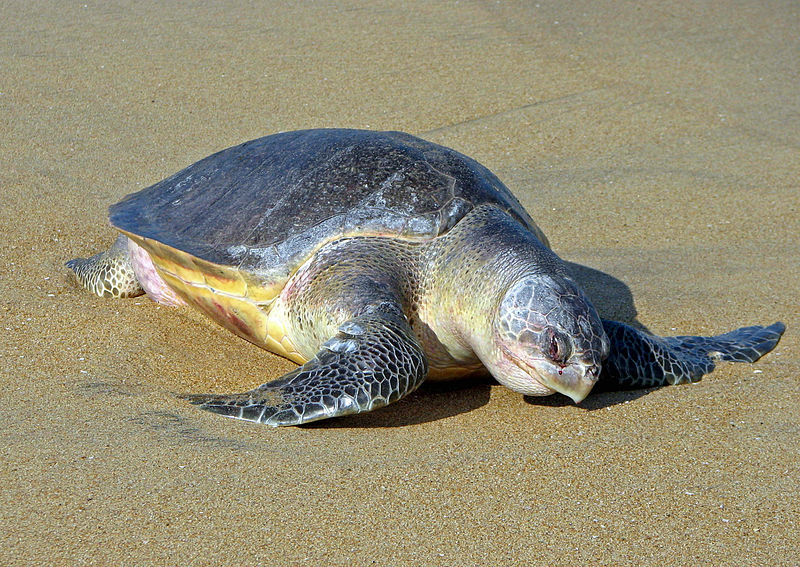
© Bernard Gagnon, Wikimedia Commons. Olive Ridley turtle, near Mahabalipuram, Tamil Nadu, India
For turtle enthusiasts, 2014 began on a tragic note with 23 dead Olive Ridleys being washed ashore between Napier Bridge and Neelankarai in the last two days.
In the last week, 35 dead turtles were found on the same stretch and this is just the tip of the iceberg.
"Studies show that only 5% to 7% of the carcasses wash ashore," said Akila Balu, convener of Students' Sea Turtle Conservation Network (SSTCN).
Olive Ridleys are protected under Schedule 1 of the Wildlife Protection Act and are considered keystone species, which means they play a critical role in the health of their environment. They keep the population of jelly fish in check and by feeding on sponges, they let coral reefs flourish. "It was very depressing to see so many turtles bloated and bleeding on the beach," said R Nishant, a volunteer from SSTCN who scouted the beach on Monday night between Srinivasapuram and Napier Bridge. The female turtles come ashore to lay their eggs on the beach.
The biggest threat to turtles is the uncontrolled number of fishing trawlers. Olive Ridleys get caught in their nets and fishermen cut off the turtles' flippers and throw them back into the sea. Since they have to swim to the surface to breathe, without flippers they drown. "The local artisan fishermen treat them as god and do not harm turtles. They have been helpful in conservation activities over the last 25 years," said Balu. So many carcasses washing ashore also indicate that the nesting turtles are near the coast.
On Monday night, the first nest of the season was found in Neelankarai. The nesting season begins in January and goes on till March. Last year, SSTCN volunteers found and relocated 225 nests along the 14km stretch, releasing more than 18,000 hatchlings. "Last year, we wrote to the chief minister's cell to regulate trawlers, at least during the nesting season. We received vague responses," said Balu. Olive Ridleys are the smallest and the most abundant of the seven species of sea turtles and nest along India's coast. Five of the seven come to India. Only Olive Ridleys come to the eastern coast while green turtles go to parts of Maharashtra and Gujarat.
Forty-five to 60 days after the eggs are laid, the hatchlings come out. By instinct, they head towards the brighter horizon, which in nature is always the sea. Drawn by artificial lights from buildings and streetlamps, hatchlings head towards the land and get eaten by dogs, crows or simply dehydrate and die. SSTCN volunteers move the nests to a hatchery and release the hatchlings into the sea.
Life in dangerStudies show only 5% to 7% of the carcasses wash ashore, making the 35 dead turtles found in one week a small number
Saving the speciesOlive Ridleys are protected under Schedule 1 of the Wildlife Protection Act They nest between January and March They are the smallest and most abundant of the seven species of sea turtles
Threats they faceAdult turtles get trapped in the nets of trawlers. Fishermen often cut off the flippers Hatchlings are drawn to artificial light and often go towards land, where they die Nests are vulnerable to poaching and eaten by dogs
Conservation movesGroups walk particular stretches looking for 'tracks' left behind by a nesting turtle Where the tracks meet, a small clearance can be found The nests are located where the sand is loose, and the eggs taken out and relocated
Reader Comments
to our Newsletter